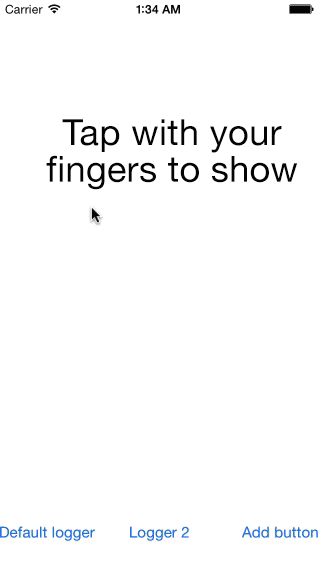DVFloatingWindow 0.3.1
| TestsTested | ✗ |
| LangLanguage | Obj-CObjective C |
| License | MIT |
| ReleasedLast Release | Dec 2014 |
Maintained by Unclaimed.
DVFloatingWindow 0.3.1
- By
- Dmitry Vorobyov
DVFloatingWindow is a simple and effective tool for reviewing your application logs just from within.
You can manage them by creating a separate tab for each log, quickly switch between tabs and see all the details you need. Also there is an opportunity to add buttons with your custom handlers for helping you to debug your app (e.g. send a network request, reset settings, etc.).
Installation
There are two possible methods to include DVFloatingWindow in your project:
-
Using CocoaPods:
- Add pod entry for DVFloatingWindow to your Podfile
pod 'DVFloatingWindow' - Install the pod by running
pod install
- Add pod entry for DVFloatingWindow to your Podfile
-
Manually:
- Get the latest version
- Drag files from DVFloatingWindow folder to your project (Check Add to target and Copy items into destination group's folder checkboxes)
Enable DVFloatingWindow in your <Project name>-Prefix.pch file. Import a header file if you want to make it visible all over your project. Don't forget to disable DVFloatingWindow before submitting your app to AppStore!
#define DV_FLOATING_WINDOW_ENABLE 1
// uncomment if you want to make FLoatingWindow accessible all over project
//#import "DVFloatingWindow.h"Usage
Setup the window display
First of all set gestures for showing/hiding the window (tap or long press).
// to show/hide the window with 3 fingers tap
DVWindowActivationTap(3);// to show/hide the window with 2 fingers long press for 0.5 second
DVWindowActivationLongPress(2, 0.5);You can show/hide the window programmatically as well.
DVWindowShow();
DVWindowHide();Log to default logger
By default DVFloatingWindow has a Default logger tab. Logging to it is as simple as using NSLog:
DVLog(@"Current date and time: %@", [NSDate date]);Create custom loggers
You have to create custom loggers before using them. Any loggers methods take NSString * argument as a logger identifier.
DVLoggerCreate(@"My custom logger");
// and now you can log
DVLoggerLog(@"My custom logger", @"Here is current date again %@", [NSDate date]);
// a shorter version of previous macro
DVLLog(@"My custom logger", @"Hello");
// Default logger identifier is @"Default", so these two lines are similar
DVLLog(@"Default", @"This is an explicit way of logging to Default logger");
DVLog(@"This is an implicit way");
// to clean up all you've logged before
DVLoggerClear(@"Default");
// to delete logger if you don't need it anymore
DVLoggerRemove(@"My custom logger");
// you no longer have "My custom logger", so this line does nothing
DVLLog(@"My custom logger", @"You won't receive this message");To configure logger please see Configuration section.
Add buttons with handlers
If you need to clean NSUserDefaults, to send a request to server or to simulate a push receiving, you can add buttons with custom handlers.
// Button title, handler
DVButtonAdd(@"Remove authorization token", ^{
[[NetworkManager sharedInstance] removeAuthorizationToken];
});Switch tabs
// go forward
DVTabNext();
// go back
DVTabPrevious();
// show the Default logger
DVTabSwitchToLogger(@"Default");
// show tab with buttons
DVTabSwitchToButtonsTab();Configuration
DVFloatingWindow has some amount of configurable options. All of them start with DVConfig prefix.
// you can get or set frame at any time:
CGRect dvFrame = DVConfigFrameGet();
dvFrame.origin.x = 30.0;
dvFrame.origin.y = 20.0;
DVConfigFrameSet(dvFrame);
// you can change all colors
DDLog(@"My old background color was %@", DVConfigBackgroundColorGet());
DVConfigBackgroundColorSet([UIColor grayColor]);
DDLog(@"My new background color is %@", DVConfigBackgroundColorGet());
// making it red
DVConfigTopBGColorSet ([UIColor redColor]);
DVConfigTopMenuBGColorSet ([UIColor darkGrayColor]);
DVConfigTopTextColorSet ([UIColor whiteColor]);
DVConfigRightCornerColorSet ([UIColor redColor]);You can set or get default email options.
DVConfigEmailToRecipientsSet(@[@"[email protected]", @"[email protected]"]);
DVConfigEmailCcRecipientsSet(@[@"[email protected]"]);
DVConfigEmailSubjectSet(@"My app logs");
DVConfigEmailMessageBodySet(@"Here are some logs:");
DVConfigEmailIsMessageBodyHTMLSet(NO);Loggers have only set methods, first argument is always loggerKey.
DVConfigLoggerLatestMessageOnTop(@"Default", YES);
DVConfigLoggerFont(@"Pushes logger", [UIFont systemFontOfSize:17.0]);Release
When your app is ready to release simply disable DVFloatingWindow.
#define DV_FLOATING_WINDOW_ENABLE 0System Requirements
iOS 5.0 and greater
Useful hints
Redirecting NSLog
To send all your NSLogs to Xcode console and DVFloatingWindow just add this macro to <Project name>-Prefix.pch file.
#define NSLog(format, ...) DVLog(format, ##__VA_ARGS__); NSLog(format, ##__VA_ARGS__)Integrate with CocoaLumberjack
CocoaLubmerjack is a cool logger for iOS and OS X. To integrate DVFloatingWindow with it you should get DVFloatingLumberjack logger.
Bugs and feature requests
Found a bug? Have a feature request? Please submit an issue.
Changelog
Contact
License
DVFloatingWindow is available under the MIT license. See the LICENSE file for more info.

